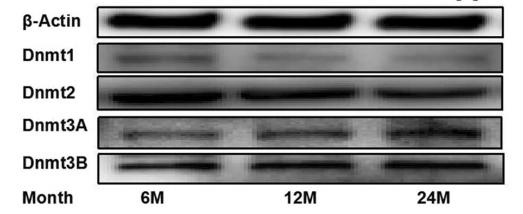产品描述
*The optimal dilutions should be determined by the end user.
*Tips:
WB: 适用于变性蛋白样本的免疫印迹检测. IHC: 适用于组织样本的石蜡(IHC-p)或冰冻(IHC-f)切片样本的免疫组化/荧光检测. IF/ICC: 适用于细胞样本的荧光检测. ELISA(peptide): 适用于抗原肽的ELISA检测.
引用格式: Affinity Biosciences Cat# DF7376, RRID:AB_2839314.
展开/折叠
ADCADN; AIM; CXXC finger protein 9; CXXC-type zinc finger protein 9; CXXC9; DNA (cytosine 5 ) methyltransferase 1; DNA (cytosine-5)-methyltransferase 1; DNA methyltransferase 1; DNA methyltransferase HsaI; DNA methyltransferase M.HsaI.; DNA MTase; DNA MTase HsaI; DNMT 1; DNMT; Dnmt1; DNMT1_HUMAN; Dnmt1o; FLJ16293; HSN1E; M.HsaI; MCMT; Met1; MGC104992; mMmul; MommeD2;
抗原和靶标
Ubiquitous; highly expressed in fetal tissues, heart, kidney, placenta, peripheral blood mononuclear cells, and expressed at lower levels in spleen, lung, brain, small intestine, colon, liver, and skeletal muscle. Isoform 2 is less expressed than isoform 1.
- P26358 DNMT1_HUMAN:
- Protein BLAST With
- NCBI/
- ExPASy/
- Uniprot
MPARTAPARVPTLAVPAISLPDDVRRRLKDLERDSLTEKECVKEKLNLLHEFLQTEIKNQLCDLETKLRKEELSEEGYLAKVKSLLNKDLSLENGAHAYNREVNGRLENGNQARSEARRVGMADANSPPKPLSKPRTPRRSKSDGEAKPEPSPSPRITRKSTRQTTITSHFAKGPAKRKPQEESERAKSDESIKEEDKDQDEKRRRVTSRERVARPLPAEEPERAKSGTRTEKEEERDEKEEKRLRSQTKEPTPKQKLKEEPDREARAGVQADEDEDGDEKDEKKHRSQPKDLAAKRRPEEKEPEKVNPQISDEKDEDEKEEKRRKTTPKEPTEKKMARAKTVMNSKTHPPKCIQCGQYLDDPDLKYGQHPPDAVDEPQMLTNEKLSIFDANESGFESYEALPQHKLTCFSVYCKHGHLCPIDTGLIEKNIELFFSGSAKPIYDDDPSLEGGVNGKNLGPINEWWITGFDGGEKALIGFSTSFAEYILMDPSPEYAPIFGLMQEKIYISKIVVEFLQSNSDSTYEDLINKIETTVPPSGLNLNRFTEDSLLRHAQFVVEQVESYDEAGDSDEQPIFLTPCMRDLIKLAGVTLGQRRAQARRQTIRHSTREKDRGPTKATTTKLVYQIFDTFFAEQIEKDDREDKENAFKRRRCGVCEVCQQPECGKCKACKDMVKFGGSGRSKQACQERRCPNMAMKEADDDEEVDDNIPEMPSPKKMHQGKKKKQNKNRISWVGEAVKTDGKKSYYKKVCIDAETLEVGDCVSVIPDDSSKPLYLARVTALWEDSSNGQMFHAHWFCAGTDTVLGATSDPLELFLVDECEDMQLSYIHSKVKVIYKAPSENWAMEGGMDPESLLEGDDGKTYFYQLWYDQDYARFESPPKTQPTEDNKFKFCVSCARLAEMRQKEIPRVLEQLEDLDSRVLYYSATKNGILYRVGDGVYLPPEAFTFNIKLSSPVKRPRKEPVDEDLYPEHYRKYSDYIKGSNLDAPEPYRIGRIKEIFCPKKSNGRPNETDIKIRVNKFYRPENTHKSTPASYHADINLLYWSDEEAVVDFKAVQGRCTVEYGEDLPECVQVYSMGGPNRFYFLEAYNAKSKSFEDPPNHARSPGNKGKGKGKGKGKPKSQACEPSEPEIEIKLPKLRTLDVFSGCGGLSEGFHQAGISDTLWAIEMWDPAAQAFRLNNPGSTVFTEDCNILLKLVMAGETTNSRGQRLPQKGDVEMLCGGPPCQGFSGMNRFNSRTYSKFKNSLVVSFLSYCDYYRPRFFLLENVRNFVSFKRSMVLKLTLRCLVRMGYQCTFGVLQAGQYGVAQTRRRAIILAAAPGEKLPLFPEPLHVFAPRACQLSVVVDDKKFVSNITRLSSGPFRTITVRDTMSDLPEVRNGASALEISYNGEPQSWFQRQLRGAQYQPILRDHICKDMSALVAARMRHIPLAPGSDWRDLPNIEVRLSDGTMARKLRYTHHDRKNGRSSSGALRGVCSCVEAGKACDPAARQFNTLIPWCLPHTGNRHNHWAGLYGRLEWDGFFSTTVTNPEPMGKQGRVLHPEQHRVVSVRECARSQGFPDTYRLFGNILDKHRQVGNAVPPPLAKAIGLEIKLCMLAKARESASAKIKEEEAAKD
种属预测
score>80的预测可信度较高,可尝试用于WB检测。*预测模型主要基于免疫原序列比对,结果仅作参考,不作为质保凭据。
High(score>80) Medium(80>score>50) Low(score<50) No confidence
研究背景
Methylates CpG residues. Preferentially methylates hemimethylated DNA. Associates with DNA replication sites in S phase maintaining the methylation pattern in the newly synthesized strand, that is essential for epigenetic inheritance. Associates with chromatin during G2 and M phases to maintain DNA methylation independently of replication. It is responsible for maintaining methylation patterns established in development. DNA methylation is coordinated with methylation of histones. Mediates transcriptional repression by direct binding to HDAC2. In association with DNMT3B and via the recruitment of CTCFL/BORIS, involved in activation of BAG1 gene expression by modulating dimethylation of promoter histone H3 at H3K4 and H3K9. Probably forms a corepressor complex required for activated KRAS-mediated promoter hypermethylation and transcriptional silencing of tumor suppressor genes (TSGs) or other tumor-related genes in colorectal cancer (CRC) cells. Also required to maintain a transcriptionally repressive state of genes in undifferentiated embryonic stem cells (ESCs). Associates at promoter regions of tumor suppressor genes (TSGs) leading to their gene silencing. Promotes tumor growth.
Sumoylated; sumoylation increases activity.
Acetylation on multiple lysines, mainly by KAT2B/PCAF, regulates cell cycle G(2)/M transition. Deacetylation of Lys-1349 and Lys-1415 by SIRT1 increases methyltransferase activity.
Phosphorylation of Ser-154 by CDKs is important for enzymatic activity and protein stability. Phosphorylation of Ser-143 by AKT1 prevents methylation by SETD7 therebye increasing DNMT1 stability.
Methylation at Lys-142 by SETD7 promotes DNMT1 proteasomal degradation.
Ubiquitinated by UHRF1; interaction with USP7 counteracts ubiquitination by UHRF1 by promoting deubiquitination and preventing degradation by the proteasome.
Nucleus.
Ubiquitous; highly expressed in fetal tissues, heart, kidney, placenta, peripheral blood mononuclear cells, and expressed at lower levels in spleen, lung, brain, small intestine, colon, liver, and skeletal muscle. Isoform 2 is less expressed than isoform 1.
Homodimer. Forms a stable complex with E2F1, BB1 and HDAC1. Forms a complex with DMAP1 and HDAC2, with direct interaction. Interacts with the PRC2/EED-EZH2 complex. Probably part of a corepressor complex containing ZNF304, TRIM28, SETDB1 and DNMT1. Interacts with UHRF1; promoting its recruitment to hemimethylated DNA. Interacts with USP7, promoting its deubiquitination. Interacts with PCNA. Interacts with MBD2 and MBD3. Interacts with DNMT3A and DNMT3B. Interacts with UBC9. Interacts with CSNK1D (By similarity). Interacts with HDAC1 (By similarity). Interacts with BAZ2A/TIP5 (By similarity). Interacts with SIRT7 (By similarity).
The N-terminal part is required for homodimerization and acts as a regulatory domain.
The CXXC-type zinc finger specifically binds to unmethylated CpG dinucleotides, positioning the autoinhibitory linker between the DNA and the active site, thus providing a mechanism to ensure that only hemimethylated CpG dinucleotides undergo methylation.
Belongs to the class I-like SAM-binding methyltransferase superfamily. C5-methyltransferase family.
研究领域
· Human Diseases > Cancers: Overview > MicroRNAs in cancer.
· Metabolism > Amino acid metabolism > Cysteine and methionine metabolism.
· Metabolism > Global and overview maps > Metabolic pathways.
文献引用
Application: WB Species: Mouse Sample: GCs
Application: WB Species: rat Sample: ovaries
Application: WB Species: Human Sample: HL-60 Cells
限制条款
产品的规格、报价、验证数据请以官网为准,官网链接:www.affbiotech.com | www.affbiotech.cn(简体中文)| www.affbiotech.jp(日本語)产品的数据信息为Affinity所有,未经授权不得收集Affinity官网数据或资料用于商业用途,对抄袭产品数据的行为我们将保留诉诸法律的权利。
产品相关数据会因产品批次、产品检测情况随时调整,如您已订购该产品,请以订购时随货说明书为准,否则请以官网内容为准,官网内容有改动时恕不另行通知。
Affinity保证所销售产品均经过严格质量检测。如您购买的商品在规定时间内出现问题需要售后时,请您在Affinity官方渠道提交售后申请。产品仅供科学研究使用。不用于诊断和治疗。
产品未经授权不得转售。
Affinity Biosciences将不会对在使用我们的产品时可能发生的专利侵权或其他侵权行为负责。Affinity Biosciences, Affinity Biosciences标志和所有其他商标所有权归Affinity Biosciences LTD.



